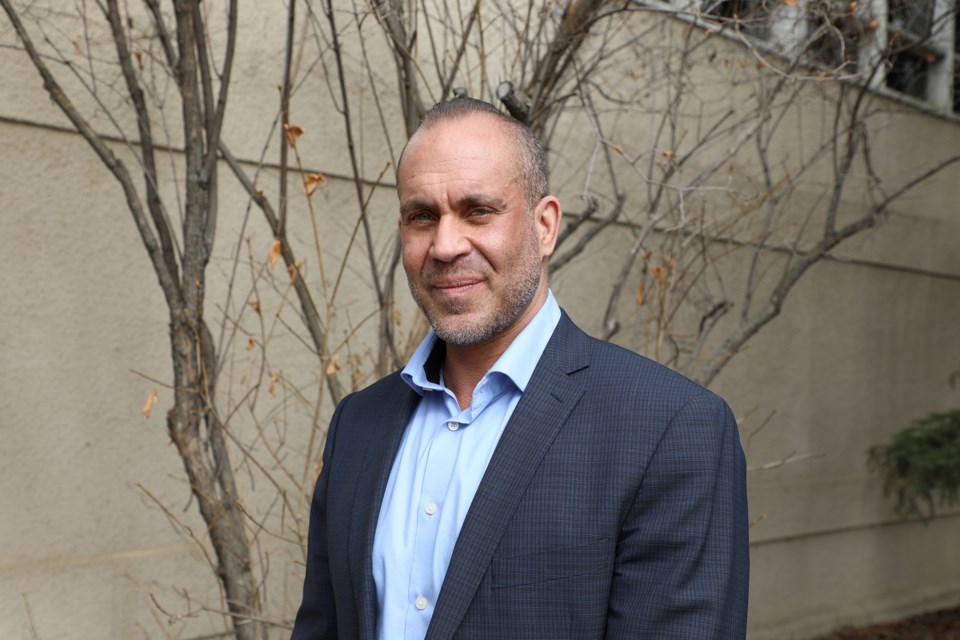You’ve probably never heard of keratoconus, and likely never seen what it can do either. The rare eye disease changes the shape of the clear cornea, which is the thin, transparent front tissue of your eye. The disease thins it even further while stretching it into a cone shape right over your iris, distorting your vision in the process.
For some, it results in only minor astigmatism. For others, it keeps progressing. The pictures of it are disconcerting enough but the experience of it can be profoundly painful and devastating. Just ask Chad Bodnar.
The local psychologist first saw what it could do when it started to take his eyesight away when he was 16 despite the special contacts he wore. You’d think that contacts would fix things. Without them, he was blind, he said.
“That alone is a journey of absolute disappointment and frustration, because you get a contact, you're paying 500 bucks out of your pocket for these special hard lenses, and in a matter of months, they no longer fit. They start rubbing against your cornea. I've had lots of scarring occur because the contact would start to rub and be tight. Your eyeball has a very high concentration of nerve endings ... so really excruciating pain, discomfort, sensitivity to light, all at the same time your vision is slowly declining,” he began.
“I always think, as a psychologist, I see why chronic pain is so frustrating and creates depression and brings you down because you’re constantly under this state of discomfort. For all my years growing, it became more challenging.”
The disease affected both of his eyes, though his left progressed faster than the right. His first transplant in his left eye was in 2015, but it was in great decline for 10 years prior to that, he noted. He experienced what is called an acute hydrops, which is where the cornea thins so much that it tears right open. It’s disgusting and awfully painful – his words – though it eventually healed, though with “nice, big scar tissue right in the centre” of his eye.
This caused a white dot in his vision. If he tried to look at someone in the distance, he wouldn’t be able to see their face.
Those declining ten years before his transplant were filled with social anxiety. He couldn’t stand to be in crowds because he couldn’t tell who was familiar and friendly or who was a threat. That anxiety led to him becoming isolated and depressed.
“I wanted to be out but it's really hard and so very strange. It's a journey that I wish upon no one. It's a lot of discomfort. I'd be in lots of pain and of course you can't take a lot of pain meds because it won't do much.”
His surgeon wanted to wait to do his transplants until he was as old as possible because corneas last 10 to 20 years depending on the quality of the tissue. It’s also important to try to get corneas from donors who are as young as possible because that helps prevent the recipient’s body from rejecting the foreign tissue.
Eventually, his left eye finally reached its limit. It was time.
“My surgeon said, ‘Your contact can’t fit. It can't be corrected. It's time for a transplant.’ Moons ago when I was in my 20s, I remember talking to an expert and they said, ‘We have to put you on a wait list and wait for a cornea to become available.’ Nowadays, there's an organ bank through the CNIB. They hooked me up with a tissue in 2015 and pretty much no wait time. It was within a couple of weeks I was already in the hospital booked for surgery.”
It’s a fairly simple two-hour surgery under general anaesthetic, he said. He describes the implement that the surgeon used as a “cookie cutter,” which leaves little to the imagination. A ring of stitches and a long period of healing and he is once again a seeing man, though one side is still better than the other.
Bodnar doesn’t take his eyesight for granted. The corneas he has now won’t last, and he’ll need more transplants later on in his life. He offers his gratitude to the Canadian National Institute for the Blind (CNIB) by participating in their golf tournament. He thanked his doctors with bottles of wine after each surgery.
If people don’t sign their donor cards, he says, other people like him don’t get opportunities to see again.
“It's our sight. We rely on our sight for so much. You don't realize it until you start losing it,” he emphasized.
“Right now, I can see quite well. I can wake up in the morning. I can read my book without glasses or contacts. My right eye, again, is doing all the work. If I get a new tissue in a couple years again, maybe this one will last for the rest of my life. I'm just very lucky I haven't rejected, and rejection is still possible. Every six months, I see my surgeon and he checks the cells and makes sure there's no changes in the relationship between the two cells. So far, so good.”




